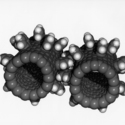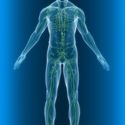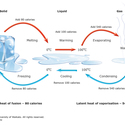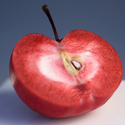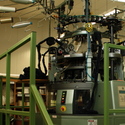Nanoscale1 silicon2 quantum dots are being developed in New Zealand. They will be able to locate and show up cancerous cells in humans, and deliver drugs to them.
What are quantum dots?
Quantum dots are nanoparticles of semiconductor3 materials, clusters of atoms only a few nanometres across. A special property4 of quantum dots is that they fluoresce5 – when ultra-violet light (invisible to human eyes) is shone on them, they re-emit the light as a visible colour. The colour they give off depends on the size and shape of the quantum dot6. It is possible to create quantum dots that emit just about any colour you want. Quantum dots are being developed for use in such things as LEDs and television screens, but they also have medical uses.
Locating cancer using quantum dots
Quantum dots that can be used to find and treat cancer are being developed by Dr Richard Tilley and others at Victoria University of Wellington and the MacDiarmid Institute for Advanced Materials and Nanotechnology7.
Many of the quantum dots developed in other countries use chemicals8 such as cadmium9. Cadmium is a highly toxic10 metal11, sitting directly above mercury in the periodic table. Dr Tilley and his team have been able to create non-toxic quantum dots using silicon.
These quantum dots can be put into single cells, or lots of cells, in the tissue of living organisms. In future, it is planned to attach specific antibodies to the quantum dots – when injected into a body, the quantum dots will find and bind to cancer12 cells, and illuminate them when they fluoresce.
There are advantages to using quantum dots rather than the current organic13 dyes used to highlight living cells:
- Quantum dots last longer. Organic dye molecules14 only last for about 30 minutes in a human body. Quantum dots can emit light for days. By following the quantum dots over time, it will be possible to monitor and show if treatment is working.
- Silicon quantum dots are less toxic.
- Quantum dots will be able to detect cancer earlier. Current detection methods, such as magnetic resonance imaging (MRI), can only detect tumours that are well developed. Quantum dots can detect individual cancer cells.
Targeted drug delivery
Eventually, it is intended to attach drug15 molecules to the quantum dots, which will then be able to deliver the drug just to the cancer cells where it is needed. Current anti-cancer drugs tend to have a range of unpleasant side-effects, because they affect the whole body, not just the cancer. The research is still in its early stages – it is hoped that quantum dots should be available to help treat cancer in about ten years.
Examples of collaboration by scientists
Nature of science
The research led by Dr Richard Tilley on quantum dots is a good example of the way different scientists collaborate to solve nanotechnology problems.
Each of the following scientists make a specific contribution to the research on quantum dots:
- Synthetic16 chemist17 (Dr Richard Tilley, MacDiarmid Institute) makes quantum dots.
- Medical scientist (Prof Kenji Yamamoto, International Medical Centre of Japan) carries out toxicity18 testing.
- Biochemist19 (Thomas Backstrom, Malaghan Institute) looks at which antibodies and drug molecules to use.
- Theoretical physicist (Shaun Hendy, Industrial Research Ltd) creates computer simulations to make predictions about quantum dot structures and properties.
Related content
The article Nanoscience explained provides an overview of nanotechnology – its history and some future possibilities in the nanotechnology field. Nanometres and nanoscale gives practical explanations of these concepts.
Activity ideas
Social issues and nanotechnology encourages students to think about the positive and negative factors of nanotechnology in their daily lives.
To explore the nanoscience20 connection, students could use modelling clay to construct catalyst nanoparticle shapes and calculate surface area21:volume ratios with the aim of trying to develop a more efficient shape.
Useful link
Read this 2023 article from Nanomaterials: Recent Breakthroughs in Using Quantum Dots for Cancer Imaging and Drug Delivery Purposes.
- nanoscale: Refers to dimensions below 100 nm. Also refers to the small size, often only a few nm, at which the properties of a substance are different to properties of bulk material.
- silicon: A semimetal – symbol Si, atomic number 14.
- semiconductor: A substance that can be made to conduct or block electricity. Silicon is a semiconductor that forms the basis of computer chips and many electronics components.
- property: A physical or chemical property is a physical or chemical state of a substance that can be measured. Any changes can be used to describe transformations between states.
- fluoresce: Produce light when exposed to radiation of a particular wavelength.
- quantum dot: A semiconductor nanocrystal, which can give out light when excited. Different size particles give off different colours.
- nanotechnology: Understanding and working with matter at the scale of atoms and molecules. 1 nanometre is a millionth of a millimetre.
- chemicals: Everything is made up of chemicals. All matter (anything made of atoms) can be called chemicals. They can be in any form – liquid, solid or gas. Chemicals can be a pure substance or a mixture.
- cadmium: A transition metal in Group 12 of the periodic table – symbol Cd, atomic number 48.
- toxic: Poisonous and harmful.
- metal: Any of a category of elements that usually have a shiny surface, are generally good conductors of heat and electricity and can be melted or fused, hammered into thin sheets or drawn into wires (for example, copper).
- cancer: The term for a group of more than 100 diseases in which abnormal cells divide and multiply uncontrollably.
- organic: 1. Molecules that contain carbon and that have a biological origin. 2. Grown using natural processes with nutrients from natural sources.
- molecule: Two or more atoms bonded together. The molecule of an element has all its atoms the same. The molecule of a compound has two or more different atoms.
- drug: A pharmaceutical drug could be a medicine or chemical substance intended for use in the medical diagnosis, cure, treatment or prevention of disease.
- synthetic: Made in a laboratory or factory by a chemical process, usually to imitate a natural process.
- chemist: A scientist trained in the science of chemistry. Chemists study the composition of matter and its properties.
- toxicity: The level of harm a toxin can cause.
- biochemist: A scientist who works in the field of how chemical processes occur in living things.
- nanoscience: The study of atoms, molecules and objects whose size is on the nanometre scale (1–100 nanometres).
- surface area: The total area of an object or surface.


